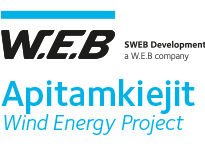Project Overview
The Apitamkiejit Wind Energy Project is a proposed renewable energy facility with a total capacity of up to 68 MW. The project will consist of up to ten turbines with a nameplate capacity between 5.9 to 7.2 MW.
The facility will be located on privately-held land in Queens county, north-west of highway 103. The project is being developed through a partnership including one or more First Nation communities that are yet to be disclosed, and SWEB Development LP (SWEB Energy), a Halifax-based renewable energy developer and operator.
The current project specific information was provided since the inception of the project in 2021. However, projects of this nature evolve over the course of their development. Consequently, please be advised that the most recent project specific information will be updated here as it becomes available, starting with the latest information available.
Milestones
| 2020 – Onward | Stakeholder Engagement | 2021 – 2026 | Environmental Assessment | 2021 – 2026 | Local Permitting | 2022 – 2026 | Future Procurement Bid Submission and Due Diligence | 2027 – 2029 | Proposed Construction Period | 2029 – 2030 | Proposed Commercial Operation Date |
|---|
Project Benefits
A central focus of the project during development, construction, and operations is to ensure that as much local labour, services, and materials are used as possible. It is anticipated that if the project is built, it will create a number of direct and indirect benefits for various stakeholders and First Nations communities. The project will have a positive impact on local businesses and will result in employment opportunities in addition to tax revenue for municipal, provincial, and federal governments. Further, a share of project revenues will be used to support local community groups and underrepresented communities in the province.
A share of project revenues will be used to support local community groups and underrepresented communities in the province. Additionally, over its 25 year lifetime, the Project will contribute, if built at maximum size, more than $17.5 million in tax revenues to its host municipality. That is an average of more than $700,000 per year.
With respect to the environment and climate change, the project is expected to significantly offset carbon dioxide (CO2) emissions from Nova Scotia’s current electricity production and will produce enough power for up to 20,000 homes.

